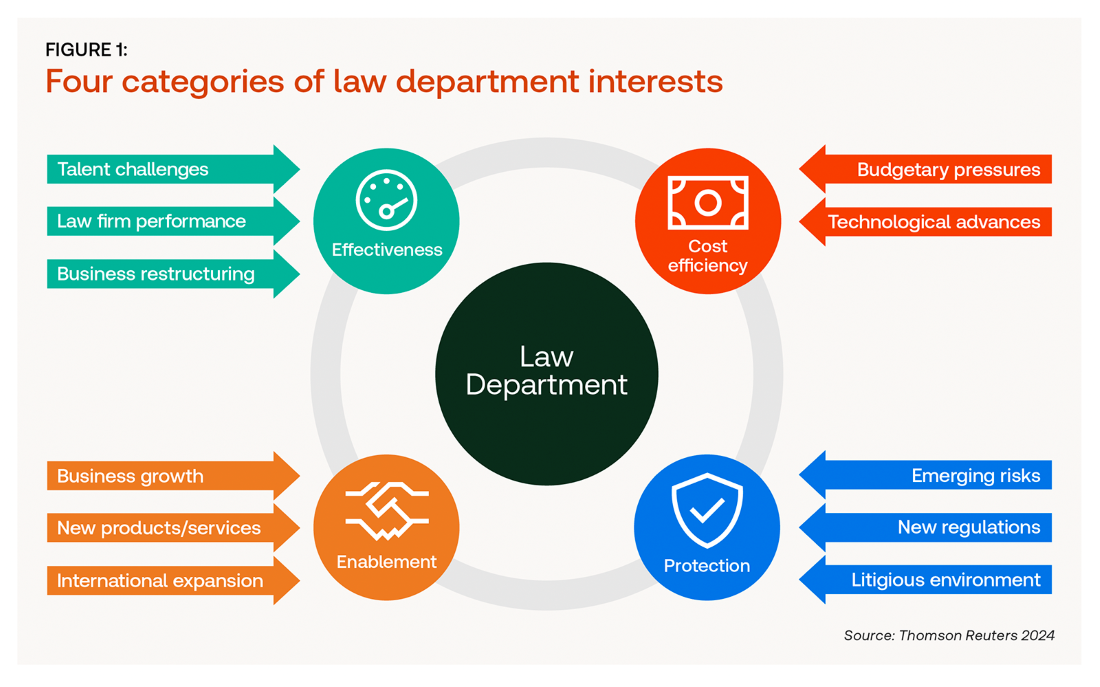With many competing priorities, corporate law department leaders can find it difficult to translate the achievements of their department into a language that the board will understand
Within the Thomson Reuters Institute, we have adopted a framework for law departments we’ve come to affectionately call the spinning plates.

This has proven to be an incredibly useful way to visualize the various areas of responsibility for today’s general counsel (GCs). Each of the four areas represents a key area of focus for GCs, each with its own challenges around how to both meet and potentially influence C-Suite perceptions surrounding the law department’s performance. While all four areas matter all the time, many GCs tell me their ultimate goal is to enable the business with the other three goals working in support of that.
There is a problem with this framework, however, in that it does not necessarily align with how the C-Suite is tracking performance for the broader business. Indeed, the C-Suite’s priorities are reflected in the goals it sets for the company, and those goals change year by year. Naturally, this puts GCs in a difficult position. The areas of responsibility reflected above are largely evergreen — a GC can never really shift away from the need to be cost effective while protecting the business.
Demonstrating the department’s worth
To prove a law department’s worth as a business enabler, the GC needs to demonstrate what the legal team has contributed to advancing the company’s goals as well as demonstrating that the department is a well-operating, efficient function. Not only that, but time in front of the C-Suite or board of directors is precious and must be used judiciously. These are audiences looking for key information that tells important details in a succinct way.
Thus, it becomes critical that GCs understand the importance of learning how to tell the story of their departments’ achievements in a way that speaks to executive leadership in one simple slide.
I recently joined my colleague Bill Josten in presenting a four-part masterclass series for the Association of Corporate Counsel on how to effectively use metrics within a corporate law department. The capstone of that series walked attendees through an exercise in which we examined the performance of a law department for a hypothetical company. Let’s go over a few of the key highlights, including:
Know your audience — What speaks to them? This requires GCs to understand the needs of the individuals involved. With that understanding, you can tailor the delivery to the particular people and their perspective on the broader organization. It is also crucial to demonstrate business savvy in terms of the way metrics are stated, how the law department is aligned with the broader goals of the business, and how the department is staying on top of the changing needs of the business.
Collect your data — It’s better to start with more information than you know what to do with than to have potential gaps in understanding. Mark Twain once said: “I didn’t have time to write a short letter, so I wrote a long one instead.” Brevity takes time — but it’s worth it, and it has to come from a place of abundance. This is where the above framework of key areas of departmental focus can be vital. If the department is consistently tracking its performance in these four areas, there should be ample data from which to draw key insights, successes, and needs, particularly over time. Also, the story should be balanced across all four areas to ensure the full range of efforts are visible, not just the cost metrics.
Apply a filter — Here is where a GC needs to apply Twain’s time for writing a short letter. It is important to pare down the volume of insights available to the GC to the key statistics and results that will tell the story of the value of the law department in a way that matters most to leadership. Framing this in the context of the business’s goals — rather than the law department’s goals — can be an incredibly valuable tool.
In the masterclass series, for example, our hypothetical company had three key goals:
-
-
- Develop and launch an AI-powered product suite within the next year;
- Grow worldwide revenue by a specific percentage, 12%; and
- Reduce operating expenses by 10%.
-
To frame the performance of the law department, we turned those broader corporate goals into specific goals for the law department:
-
-
- Enable development of AI products while mitigating risks;
- Facilitate sales cycle through training and technology to achieve a faster sales close time;
- Optimize efficiency of law department operations in line with expense reduction target; and
- Innovate legal service delivery through technology.
-
Aligning with business goals
Reporting the law department’s progress and results in the context of the company’s broader goals makes it infinitely easier for executive leadership to read, absorb, and appreciate what the GC is saying.
There are additional nuanced considerations that GCs should keep in mind as well. For example, how are the company’s goals stated? If the goals are stated in terms of savings to be achieved, then something like a decrease in headcount turnover could be framed as a savings in turnover-related costs.
This idea of framing the story in the light most likely to be favorably received by the audience is one in which lawyers should excel. Nearly every lawyer has had to think about how to frame evidence and precedent when making an argument. So, thinking of framing the presentation to the C-Suite or the board as similar to making an argument based on evidence can be an effective tool to leverage the innate lawyer mindset in a different but effective way.
While not necessarily the most natural exercise for many within the law department, when approached from the right perspective, the challenge of presenting the story of the law department’s contributions to the overall success of the business can ultimately prove to be an incredibly valuable exercise for positioning the GC as a strategic leader and enabler of the overall business’s goals.







